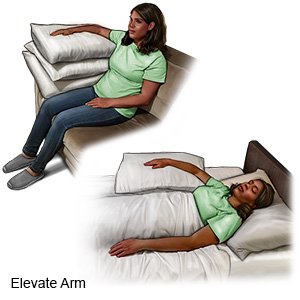Breast Cancer Sentinel Lymph Node Biopsy
Medically reviewed by Drugs.com. Last updated on Aug 4, 2025.
Information from a sentinel lymph node (SLN) biopsy can help your healthcare provider decide what other treatments you need. You may have bruising or swelling at the biopsy site. This is normal and expected. The arm closest to the biopsy site may be sore. This should get better within 48 to 72 hours.
DISCHARGE INSTRUCTIONS:
Seek care immediately if:
- Blood soaks through your bandage.
- Your stitches come apart.
- Your bruise suddenly gets larger and feels firm.
Call your doctor or oncologist if:
- You have a fever or chills.
- The biopsy area is red, swollen, or draining pus.
- You have nausea or are vomiting.
- Your skin is itchy, swollen, or you have a rash.
- Your pain does not get better, even with pain medicine.
- You have questions or concerns about your condition or care.
Medicines:
You may need any of the following:
- NSAIDs , such as ibuprofen, help decrease swelling, pain, and fever. This medicine is available with or without a doctor's order. NSAIDs can cause stomach bleeding or kidney problems in certain people. If you take blood thinner medicine, always ask your healthcare provider if NSAIDs are safe for you. Always read the medicine label and follow directions.
- Acetaminophen decreases pain and fever. It is available without a doctor's order. Ask how much to take and how often to take it. Follow directions. Read the labels of all other medicines you are using to see if they also contain acetaminophen, or ask your doctor or pharmacist. Acetaminophen can cause liver damage if not taken correctly.
- Prescription pain medicine may be given. Ask your healthcare provider how to take this medicine safely. Some prescription pain medicines contain acetaminophen. Do not take other medicines that contain acetaminophen without talking to your healthcare provider. Too much acetaminophen may cause liver damage. Prescription pain medicine may cause constipation. Ask your healthcare provider how to prevent or treat constipation.
- Take your medicine as directed. Contact your healthcare provider if you think your medicine is not helping or if you have side effects. Tell your provider if you are allergic to any medicine. Keep a list of the medicines, vitamins, and herbs you take. Include the amounts, and when and why you take them. Bring the list or the pill bottles to follow-up visits. Carry your medicine list with you in case of an emergency.
Related medications
Care for the biopsy area as directed:
Ask your healthcare provider when the area can get wet. Carefully wash around the area with soap and water. It is okay to let soap and water gently run over the area, but do not scrub it. Gently pat the area to dry it. Then put on new, clean bandages as directed. Change your bandages when they get wet or dirty. If you have strips of medical tape, let them fall off on their own. It may take 10 to 14 days for them to fall off. Check the area every day for signs of infection, such as redness, swelling, or pus. Do not put powders or lotions on the area. If lymph nodes have been taken from your armpit, ask your provider when you can wear deodorant.
Self-care:
- Apply ice on your wound for 15 to 20 minutes every hour or as directed. Use an ice pack, or put crushed ice in a plastic bag. Cover it with a towel before you apply it to your skin. Ice helps prevent tissue damage and decreases swelling and pain.
- Elevate your arm nearest to the biopsy site as often as you can. This will help decrease swelling and pain. Prop your arm on pillows or blankets to keep it elevated above the level of your heart comfortably.

- Do not do strenuous activities for 24 to 48 hours. Strenuous activities include heavy lifting, sports, or running. If lymph nodes were taken from your armpit, do not push or pull with your arm. These activities may put too much stress on the biopsy area. Rest and take short walks around the house. Ask your healthcare provider when you can return to your normal activities.
- Drink plenty of liquids as directed. This will help flush out contrast liquid from your body. Ask how much liquid to drink each day and which liquids are best for you.
Ask your healthcare provider how to prevent lymphedema and infection:
An infection in your skin can make lymphedema worse. Ask your healthcare provider how you can decrease your risk for skin infections and lymphedema.
Follow up with your doctor or oncologist as directed:
Write down your questions so you remember to ask them during your visits.
© Copyright Merative 2025 Information is for End User's use only and may not be sold, redistributed or otherwise used for commercial purposes.
The above information is an educational aid only. It is not intended as medical advice for individual conditions or treatments. Talk to your doctor, nurse or pharmacist before following any medical regimen to see if it is safe and effective for you.
Further information
Always consult your healthcare provider to ensure the information displayed on this page applies to your personal circumstances.
